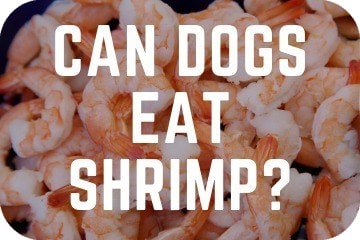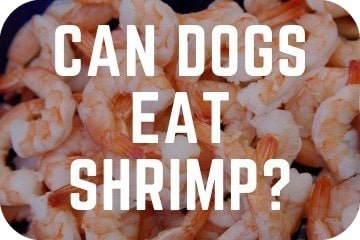
Can Dogs Eat Shrimp? Yes, dogs can eat shrimp, but it must be in moderation and follow the strict guidelines. Shrimp provides dogs with excellent nutrients, vitamins, minerals, and antioxidants, including; protein, vitamin B12, phosphorus, iron, and niacin. This article will provide you with information regarding the importance of these types of nutrients, how to cook prawns for your dog, other nutritional seafood, and healthy seafood dog recipes.
Busy? Get Your Hands Paws On The Answers Quickly…
CAN DOGS HAVE SHRIMP?
As mentioned above, yes, dogs can eat shrimp or prawns, but it must be given in moderation, also prepared and cooked correctly. You’ll find pretty much all canines love meat. Not only is it full of flavor, but it also provides the nutrients needed to enhance their muscle mass.
When we talk about meat for dogs, we generally don’t think of seafood, especially shellfish like shrimp – in fact, shrimp is an excellent source of protein and is perfectly fine for dogs (when cooked properly).
As with all dog-friendly foods, there are plenty of health benefits, as well as some concerns that need to be addressed.
Health Benefits
Protein
This is an essential part of a dogs’dogs’ healthy and balanced diet. Just like the human body, proteins primary function is to repair muscle tissue, as well as other tissue within the body. This is very important for dogs as they’re exercising a lot, and damage to their muscle tissue can become a regular occurrence.
Dogs’ can get around 24g of protein from 100g of shrimp. As well as this, it only contains around 100 calories per 100g serving, making it a delicious and healthy treat for dogs.
Vitamin B12
This vitamin is of high importance for various aspects of your dog’s health. It is an essential vitamin to help function the nervous system and brain. It also enhances the growth of blood cells and their formation. Finally, it also improves intestinal health and helps to maintain healthy digestion!
Phosphorus
This helps to ensure your dogs remain healthy and grow properly. Phosphorus is also an essential component of kidney function.
Furthermore, it also helps muscle contractions, which aid the functions of movement. A lack of phosphorus would inhibit a dog’s daily exercise routines such as walking, running, and even chewing. Phosphorus also helps your dog to maintain a steady heart rate, especially during exercise.
Selenium
Scientific research suggests that selenium reduces the risk of getting cancer in both dogs and humans. However, it is primarily known to significantly improve dry skin and hair growth, which for dogs is excellent as their coat will be extra soft & shiny!
Health Concerns
Unfortunately, as with all foods, there are health concerns as well as the benefits. Read what follows carefully, as there is essential information regarding shrimp and dogs.
NO Raw Shrimp
Veterinary health experts suggest that feeding your dogs raw seafood can have severe implications on their health and well-being. Raw shrimp can contain a variety of bacteria, such as; E.Coli, salmonella, and listeria.
If you have fed your dog any type of seafood or shellfish, and they start to show symptoms (below), then you should instantly contact your local veterinarian or an emergency vet.
Symptoms:
> Fever
> Vomiting
> Diarrhea
> Weight Loss
> Dehydration
> Itchy Skin & Sores
> Discolored & Swollen Lips
Potential Shrimp Allergens
As previously mentioned, the bacterium on shellfish can cause your dog some horrific symptoms. As well as this, your dog may also be allergic to shellfish or even in some cases, fish as a whole. If your dog is showing similar symptoms to those above, then your dog may be allergic.
To “test the waters” with new foods, it is a good idea to feed your dog a smaller portion, to begin with, and then closely monitor their behavior. If they start to show any of the symptoms, you should contact your veterinarian to discover whether your dog has any allergens or it was the bacterium on the fish. It would be a good idea to avoid any other fish until you have spoken with your vet.
Potential Choking Hazard
When eating shellfish (especially shrimp), the shells will tend to cause problems for dogs. Not only is it hard for them to digest, but it can also be a potential choking hazard.
If you’re preparing the shrimp for your dogs, ensure the shells are completely removed before giving it to them. This will help remove the possibility of them choking.
PREPARING SHRIMP FOR YOUR DOG TO EAT
As previously mentioned, the skin and shells of prawns cause problems for our furry friends. Therefore, when purchasing prawns, it is better to have them pre-peeled (without the skin or shells).
Boiling
If the prawns you have brought still have the shells on, you’ll need to boil them on a medium to high heat until they turn pink. Once ready, you’ll need to peel the prawns and remove the shells and skin. For more information on how to do this, click here.
When you’re cooking the shrimp, you’ll have to consider your dog’s dietary needs. Frying the shrimp is not a good idea, hence the ”boiling” subtitle. Large amounts of fat (fried food) will cause your dog to have an upset stomach due to inflammation around the pancreas.
Furthermore, avoid adding any seasoning to the shrimps. Salt, pepper, garlic, and onion powders can be toxic for your dogs and therefore, should not be added at all. Take this into consideration when purchasing cooked prawns, check the packaging to ensure no other ingredients have been added.
WHAT OTHER SEAFOOD CAN A DOG EAT?
As well as shrimp, they’re a variety of other fish that dogs can eat. This section of the article will give in-depth information about the four most popular and nutritious fish varieties.
Salmon
This salt-water fish is native to the ocean waters of Alaska, Californian coast, and the Pacific Northwest. It is a ray-finned type of fish and belongs to the Salmonidae family, along with; trout, char grayling, and whitefish,
Salmon has a variety of nutrients that are highly beneficial for you and your dog. Salmon has high levels of omega-3 fatty acids, including; eicosatetraenoic acid (EPA) and docosahexaenoic acid (DHA). These two acids have some excellent benefits for your dog, which include:
> Regulates their immune system
> Helps to reduce inflammation around the muscles, bones, and joints, which can potentially lead to arthritis.
> Helps your dog produce a shiny and fluffy coat
> Reduces the risk of dry skin
> Enhances collagen levels in a dog’s system
> Fights against heart disease as well as lowering blood pressure levels
> Promote healthy weight loss in overweight or obese dogs
> Helps to provide support for dogs with kidney disease
As well as the benefits from EPA and DHA, it also has a variety of other nutrients that also make your dog a healthier one. Salmon also includes; vitamins A, D and B, and minerals such as; zinc, potassium, and magnesium.
Vitamin A
Salmon helps to provide your dog with vitamin A. Vitamin A is vital for your dog as it helps to improve and maintain their optimal health. Vitamin A also helps to keep your dogs skin, coat muscles, and nerves in working order; without this vital vitamin, dogs will become lethargic and seriously ill. Other foods high in vitamin A include; carrots, spinach, pumpkin, squash, and sweet potatoes.
Vitamin B
Vitamin B for dogs,” is vital. This vitamin is responsible for aiding the production of glucose, help function the blood cell and nervous systems, regulate hormones, and activate genes. Other foods high in B6 include; green vegetables, organ meats, whole grains, and some dairy products.
Magnesium
Magnesium is another vital mineral for dogs. Magnesium helps the dog’s body to process as well as functioning the nerve system and muscle mobilization. If you notice a change in your dogs’ muscle strength or tone, this could be down to a lack of magnesium. Foods that have high levels of magnesium include; tofu, whole grains, fish, and nuts.
Potassium
It helps in organ function and regulating the internal pH levels.
As well as salmon, dogs can also eat other highly nutritious fish such as sardines and tuna. These two types of fish offer similar nutritious value as salmon does. However, if feeding your dog tuna, you should be careful about the quantity as tuna can contain mercury.
Due to the level of metals floating in our seas and oceans, some fish can swallow small amounts of it, hence where the mercury comes from. Mercury poisoning can occur in dogs if they eat anything containing high levels of mercury. If you notice your dog with any of the following symptoms after eating tuna, you should call the vet straight away.
Mercury Poisoning Symptoms
> Lack of coordination and tremors
> Begins to lose sight
> Loss of hair
As previously mentioned, sardines and salmon offer the same nutritional values as tuna minus the possibility of it containing mercury. Therefore, it could be a wise choice to avoid feeding your dog tuna, if at all possible.
Finally, it is essential to note that all fish for your dogs should be thoroughly cooked, as this will kill any harmful bacteria that may harm your dog.
FAQS
What If My Dog Ate Shrimp Tails?
If the tails have been cooked, there is not too much to worry about. The only potential problem will be a choking hazard. However, if the shrimp tail is raw and has not been cooked, you should closely monitor your dog. If your dog starts to show signs of vomiting, diarrhea, and becoming lethargic – you should phone your vet and book an appointment straight away.
Can Dogs Eat Broccoli?
Yes. Dogs can eat cooked broccoli, but raw broccoli isn’t recommended. However, owners must remember to limit portion sizes as too much broccoli can cause stomach problems. Broccoli is full of fiber and vitamin C. Therefore, it is full of nutrients and the perfect snack for your dogs. For more information regarding dogs and broccoli, read our article “Can Dogs Eat Broccoli?”.
Why Do Dogs Eat Grass?
It could be for a variety of reasons, including they are nutrient deficient, sick, or simply because it tastes good. For more information regarding this, read our article “Why Do Dogs Eat Grass?”.
Looking for more pawsome posts? Check these out…
Can Dogs Eat Lettuce?
How To Make A Snuffle Mat
When Do Puppies Lose Their Teeth?
Can Dogs Eat Broccoli?
Can Dogs Eat Watermelon?
Disclaimer: Each dog is different, and every circumstance is different. All efforts have been made to provide accurate information. However, it is not provided by a qualified Veterinarian, Veterinarian Surgeon, or Behaviorist. The information provided is purely educational. The information should not be used as an alternative or substitute for medical care. If you have any health or medical concerns, contact a qualified Veterinary Surgeon or Veterinarian immediately.











No Comment! Be the first one.